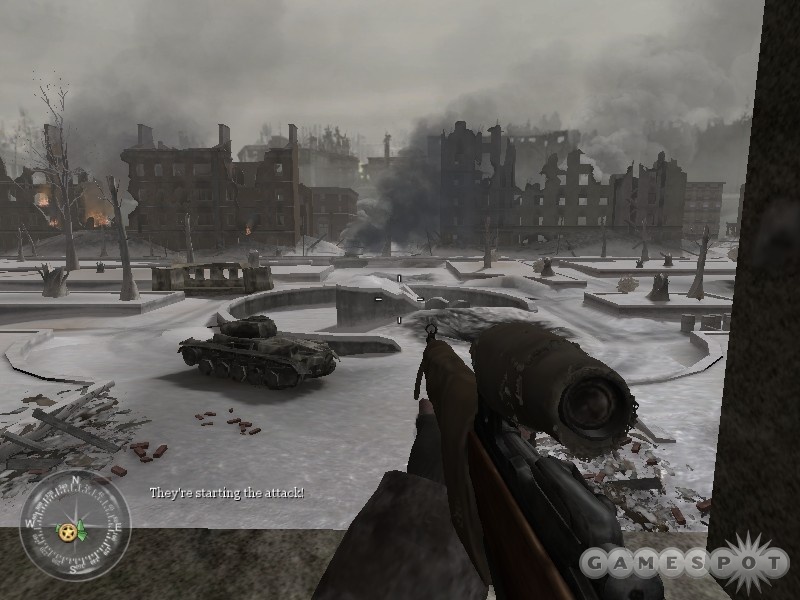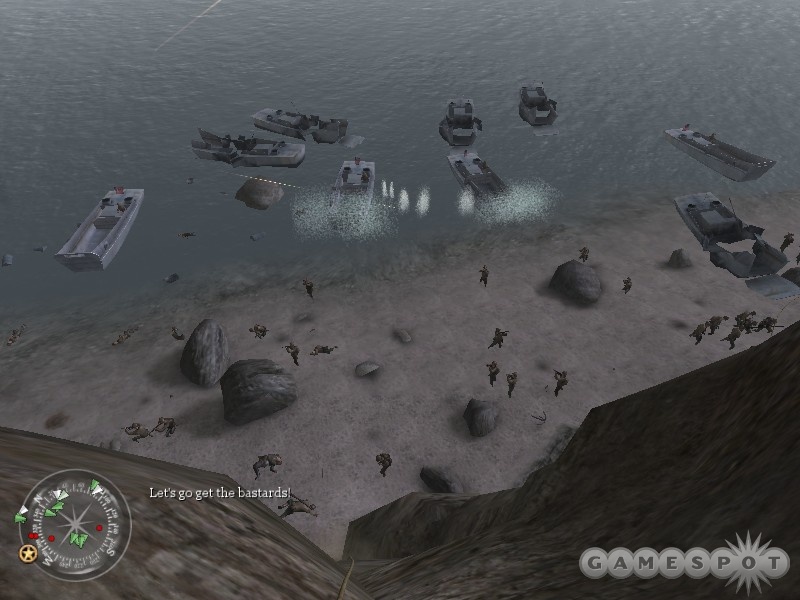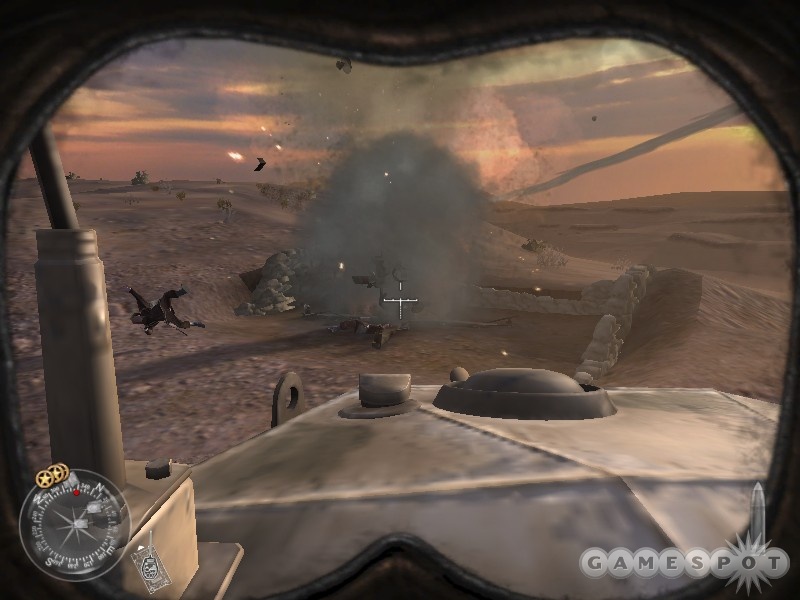When the original Call of Duty was released a few years ago, it made an impact both on critics and on consumers, even in the already-crowded WWII shooter genre. Call of Duty's visceral action struck a chord with PC shooter fans, thanks to a well-designed campaign, enjoyable multiplayer, and outstanding sound effects. If you liked those aspects of the original, then you're sure to enjoy the sequel, which stays true to the strengths of its predecessor, while enhancing the sense that you're just one soldier in the midst of a massive war machine. It doesn't really break any new ground, but the game nails the core aspects of first-person-shooter gameplay so well that it doesn't need to.

As in the first game, Call of Duty 2's campaign will put you in the shoes of a few different soldiers fighting for different Allied factions. You start off as a private in the Russian army, visciously fighting off the invading Germans in Moscow and Stalingrad. The British campaign is unlocked after beating the first Russian mission. For most of these missions you'll be fighting in the sand-swept deserts of North Africa alongside the Desert Rats against Field Marshal Rommel's troops. The final mission in the British campaign sends you to the bombed-out houses and hedgerows of Caen, France. After you're done with that, you'll play as an American corporal in Europe. Yes, you will be doing a D-Day landing, but not on Omaha Beach or Utah Beach, which you've probably played several times before. Instead, you'll be scaling the sheer cliffs of Pointe du Hoc as artillery with the Army Rangers. If you already thought rock climbing was an "extreme" sport, try doing it with artillery and machine-gun fire raining down on you.
Each of the game's 10 missions is broken up into a few different stages. If you play the game on regular difficulty, you could blow through it in about 10 hours. Ratcheting up the difficulty a notch makes the game much harder and more tactical (this is probably the experience the designers intended). Since you'll be creeping and peeking more carefully through all the encounters, you'll lengthen the campaign significantly, and enjoy it more.
Breaking up the campaign into several different narrative vignettes arguably weakens the impact of the plot as a whole, although that was never the strength of Call of Duty in the first place. What this does is allow the designers to put you in a lot of different, interesting situations. One memorable moment in the Russian campaign has you crawling through a raised pipeline to sneak behind German lines and into a fortified factory building. As you make your way through the pipeline, you'll spot and snipe small pockets of German infantry through holes in the pipe. When they fire back up at you, you'll notice bullets tearing through the rusted pipe, ripping open holes for shafts of light to poke through. It's a thrilling effect. You'll also get quite a rush from both participating in and defending against all-out infantry charges across open city squares in Stalingrad. But just as the novelty of these wears off, you're shunted over to the British campaign in North Africa, where you'll do things like participate in night raids of small Tunisian towns, climb up to the top of spires to call in artillery on enemy tanks, and even drive a tank yourself. The American campaign has its own memorable moments, like scaling the cliffs of Pointe du Hoc, or sniping at German mortar crews from the top of a grain silo. The game paces itself so that you're always on your toes, and you'll find yourself switching back and forth almost constantly from an offensive position to making a defensive stand against counterattacks on the objective you've just captured. Yes, at the end of the day you're still just shooting a lot of Nazis, but the constantly varying contexts of how and why you're doing it keep the game compelling from start to finish.

You won't be participating in these forays alone; far from it. In every setting you'll be surrounded by what seems like dozens of soldiers, both friends and foes, who move and act in a realistic fashion. Lots of your artificially intelligent mates will die by your side, along with the dozens of enemy soldiers you kill, but more will come in from the rear echelons to take their place. The designers often do a good job of reminding you that the war isn't just the infantry skirmish in which you're fighting. From time to time you'll see planes engaged in dogfights flying overhead, or when you complete an objective of capturing a German harbor, you'll call in a naval strike and see enemy merchant ships being sunk at the docks.
In each confrontation, you'll find yourself setting up at logical stopping points to exchange fire with German resistance. You can snipe dozens of enemies out of the windows and from the trenches in front of a house, for example, but reinforcements replace them. It never feels as though the game is cheaply spawning in more fodder for you; it just does a great job of making you feel like there are a realistic number of soldiers holed up in a building. You need to get a feel for the flow of each pitched battle, and this can be done by advancing your line when the enemy ranks look thin enough, and then breaking into the house or bunker. Your allies will follow you in and help you clear out the objective. Of course, if you're too meek at attacking and pressing your advantage, the enemy AI is wily and aggressive enough to take charge. They're not afraid to pour fire on your position and toss tons of grenades at you. Thankfully, a handy grenade danger indicator lets you know when and where you have to scurry away from an impending blast. When you do die, the game reloads very quickly, and you're even treated to a quote about war from various historical figures. One that sticks out in our minds is an ironic one from Solomon Short: "The only winner in the War of 1812 was Tchaikovsky."
One aspect of gameplay that has changed since the first Call of Duty is that you no longer have a health bar. As you get shot, you'll see the screen growing more and more red along the borders and your character will start to grunt and pant. If you continue to take damage in a short span of time, you die. So as you get shot that first or second time, you need to get yourself back to cover and hide for a couple of seconds to recover. Once your vision clears, you're good to go again. Some people may be put off by this Halo-like gameplay conceit, but it actually works very well here, and it really is no more contrived than hunting down and hoarding health packs. In the context of Call of Duty 2, we'd go so far as to say that it's an improvement over the traditional health system, as you never find yourself at a tough checkpoint (the game autosaves quite a lot) without enough health or medikits. Ammo's never an issue either, as there's never a shortage of dead bodies to loot for guns, bullets, and grenades. The focus stays squarely on the fight.

Speaking of grenades, the other major new gameplay conceit is the use of smoke grenades. You can pop these in front of machine-gun nests or to obscure the view of enemy snipers, making infantry charges a more viable option. The smoke effect looks outstanding and comes in handy in both the single- and multiplayer aspects to neutralize the effectiveness of fixed machine-gun nests and snipers. There's also nothing quite as exciting as running through a dense smoke cloud and finding yourself face-to-face with the enemy (the view from the opposite side is pretty cool as well).
Multiplayer Call of Duty 2 picks up right where the original left off, offering standard deathmatch, team deathmatch, and capture-the-flag modes, along with the search-and-destroy mode from the original game, where one team has to plant a bomb and destroy one of two objectives while the other team defends. A mode called "headquarters" is also available, and it's probably the most enjoyable mode of the five available in COD2. In this mode, two different areas on a map are designated as capture points for either of the two teams. To score points, a team must control and set up a headquarters on one of the two areas. Once that's set up, points begin increasing for the controlling team. The other team must attempt to overrun the position to try to stop the points from ticking up. During the time a headquarters is set up, the defending team members can't respawn (if they're killed) until their headquarters is overrun or the HQ expires. Once one of those two things happens, capture points are changed to different locations and the teams begin anew to try to set up a base. The nature of capturing, defending, and a constantly shifting HQ location makes this mode fun, because teams must adapt to different roles quickly and on the fly. As far as weapon balance goes, there's a predictable relationship between bolt-action rifles, semiautomatic rifles, assault rifles, and submachine guns. The smoke grenades can also change battlefield dynamics greatly, as snipers can sometimes find their favorite killing fields obscured. The shotguns are also extremely powerful in close-quarters situations, and they're fun to use.

The presentation in Call of Duty 2 is also topflight. Each mission is introduced with video footage from the Military Channel, as well as documentary-style narration that helps set the historical setting for what you're about to do. The game's graphics are also great, particularly the smoke effects from smoke grenades and explosions, as well as the fantastic amount of detail put into both the indoor and outdoor environments across a wide variety of landscapes. Textures can sometimes be a little less sharp when looking at vehicles or character models up close. But since most of the game is so fast and chaotic anyway, you don't notice much. The unfortunate thing is that the game can chug very badly in some key spots, reducing frame rate to 15 or less. For the most part, it ran well on our primary test system, a Pentium 4 2.4GHz with 1GB of RAM and a GeForce 6800 OC with 128MB. But in certain spots, like some massed infantry charges, or the armored-car getaway sequence, our rig really struggled to keep up, even using the game's chosen "optimal" graphics setup, which seemed somewhat modest. Sound is where Call of Duty 2 excels like no other. Between the stirring score that kicks up during key moments, to the top-notch gun and explosion effects, the game sounds fantastic. The speech is also pretty good, particularly the yelling that your squadmates and enemies do during battle, which plays right into your excitement and tension as you fight.
Call of Duty 2 is just about everything you would hope for and expect from the sequel to one of the most successful World War II shooters of all time. Its varied campaign, excellent sound and gameplay design, and generally good AI make it a worthy successor to the original. At the same time, though, it's still a World War II shooter, and if you've grown weary of them, then Call of Duty 2's lack of new material might turn you away. It can also be murderous on your computer if you have modest hardware. What Call of Duty 2 does do well is nail down just about all aspects that define an ideal first-person shooter. If you liked the original and have been thirsting for more, Call of Duty 2 will definitely deliver that.